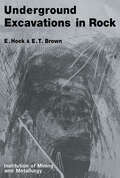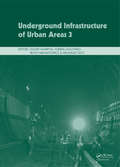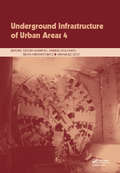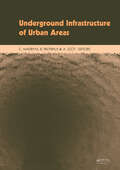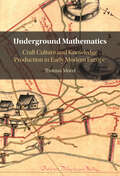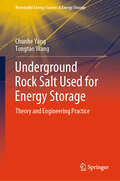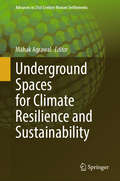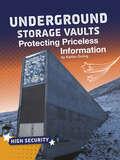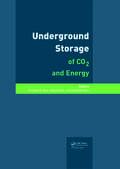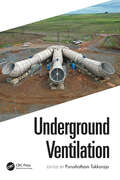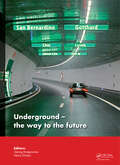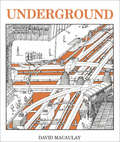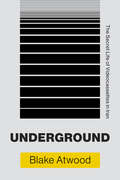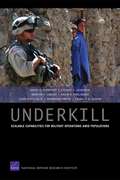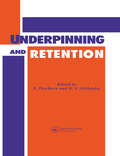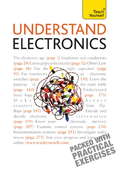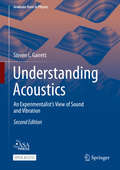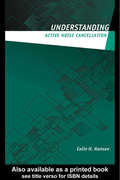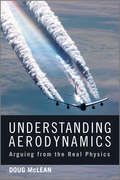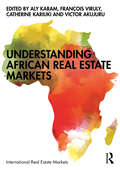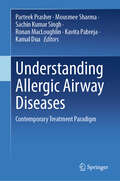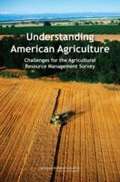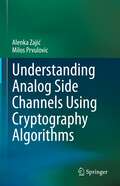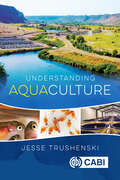- Table View
- List View
Underground Excavations in Rock
by E. Hoek E.T. BrownUnderground Excavations in Rock deals with the geotechnical aspects of the design of underground openings for mining and civil engineering processes.
Underground Infrastructure of Urban Areas 3
by Cezary Madryas Andrzej Kolonko Beata Nienartowicz Arkadiusz SzotPresenting the state-of-the-art in underground infrastructure of urbanized areas, 'Underground Infrastructure of Urban Areas 3' aims at academics, designers and builders of structures, producers and suppliers of building materials, equipment, and underground structures, and also at those managing and maintaining these structures.
Underground Infrastructure of Urban Areas 4: Proceedings of the 13th International Conference on Underground Infrastructure of Urban Areas (UIUA 2017), October 25-26, 2017, Wrockław, Poland
by Cezary Madryas, Andrzej Kolonko, Beata Nienartowicz & Arkadiusz SzotUnderground infrastructure undoubtedly constitutes one of the most important engineering equipments of urbanized areas. It includes energy distribution, communications and water, carry away sewage, transportation systems of goods and people, storage facilities of articles, liquids and gases, and commercial, recreational and research activities and other functions. Underground Infrastructure of Urban Areas 4 is dedicated to the research, design, implementation and maintenance of infrastructure systems, as well as communication tunnels and building structures (garages, tanks, etc.) in urbanized areas. The book collects contributions from several countries, presenting current scientific and technical issues associated with this area of the building industry. Both theoretical issues and cases studies on the design, execution and testing of underground infrastructures at expertise and scientific levels are included in the book. Presenting the state-of-the-art in underground infrastructure of urbanized areas, Underground Infrastructure of Urban Areas 4 aims at academics, designers and builders of structures, producers and suppliers of building materials, equipment, and underground structures, and also to those managing and maintaining these structures.
Underground Infrastructure of Urban Areas: Book + CD-ROM
by Cezary Madryas Arkadiusz Szot Bogdan PrzybyłaUnderground infrastructure (traffic and railway tunnels, water and sewage ducts, garages, and subways) is essential for urbanized areas, as they fulfill an important role in the transportation of people, energy, communication and water. Underground Infrastructure of Urban Areas is a collection of papers on the design, application, and maintenance o
Underground Mathematics: Craft Culture and Knowledge Production in Early Modern Europe
by Thomas MorelThomas Morel tells the story of subterranean geometry, a forgotten discipline that developed in the silver mines of early modern Europe. Mining and metallurgy were of great significance to the rulers of early modern Europe, required for the silver bullion that fuelled warfare and numerous other uses. Through seven lively case studies, he illustrates how geometry was used in metallic mines by practitioners using esoteric manuscripts. He describes how an original culture of accuracy and measurement paved the way for technical and scientific innovations, and fruitfully brought together the world of artisans, scholars and courts. Based on a variety of original manuscripts, maps and archive material, Morel recounts how knowledge was crafted and circulated among practitioners in the Holy Roman Empire and beyond. Specific chapters deal with the material culture of surveying, map-making, expertise and the political uses of quantification. By carefully reconstructing the religious, economic and cultural context of mining cities, Underground Mathematics contextualizes the rise of numbered information, practical mathematics and quantification in the early modern period.
Underground Rock Salt Used for Energy Storage: Theory and Engineering Practice (Renewable Energy Sources & Energy Storage)
by Chunhe Yang Tongtao WangThis book offers a thorough analysis of the mechanical properties, heat transfer, and flow characteristics as well as the monitoring techniques during the construction and operation of underground salt cavern gas storage, with an emphasis on the geological features of layered salt rocks. This information can serve as a theoretical foundation and technical guide for the underground salt cavern gas storage project. Taking into account theoretical innovations and their engineering applications, this book establishes a fundamental framework for salt cavern energy storage and covers practically every process involved in building and operating of the salt cavern energy storage. These processes include rock mechanical properties, water solution mining, gas injection for debrining, gas injection and withdrawal operation, tightness evaluation, stability assessment, operation optimization, and safety monitoring. Field engineers, researchers studying energy storage in salt caverns, and undergraduate and graduate students are the target audience for this book.
Underground Spaces for Climate Resilience and Sustainability (Advances in 21st Century Human Settlements)
by Mahak AgrawalThis book highlights the untapped potential of underground spaces as a pivotal resource for climate resilience and sustainable urban development. The book explores diverse perspectives, methodologies, and case studies that collectively illuminate the myriad ways in which subterranean environments can be harnessed to address the challenges of a changing climate and burgeoning urban populations. The book opens with an examination of Warsaw's Metro System, showcasing its role as a vital component in walkable urbanism, identifying best practices, and addressing existing barriers. Moving forward, the authors explore the integration of underground archeological spaces in Downtown Amman, emphasizing their contribution to climate adaptation and sustainable urban development. Chapters span the globe, from reviving underground practices to adapt to heat stress in unspecified locations, to unraveling the Qanat System of Yazd and its impact on urban climate resilience. "Rock Skin" introduces a process toward geological empathy, while the exploration of underground data centers and georadar technology in Jakarta highlights the technological advancements shaping the future of underground spaces. "Unveiling the Subterranean Frontier" also examines unconventional aspects such as reimagining subway station design, the utilization of underground spaces for geothermal energy, and the vital role of soil life as underground infrastructure for urban climate resilience. The book concludes with a chapter on synergies in sustainable underground space development, providing a holistic perspective on the subject. This timely and interdisciplinary compilation aims to contribute to the evolving discourse on urban resilience and sustainability, providing valuable insights for researchers, urban planners, and policymakers alike.
Underground Storage Vaults: Protecting Priceless Information (High Security)
by Kaitlyn DulingHow can important information and valuable items be kept safe as years pass? Many of these items are stored in underground vaults, including recordings and photos from U.S. history, important documents, and more. Locks, guards, secret passwords, and technology all play a part in the protection of the items. Learn more about these high-security places!
Underground Storage of CO2 and Energy
by Heping Xie Michael Z. Hou Jeoung Seok YoonOf the known greenhouse gases, political attention to date has primarily focused on carbon dioxide (CO2), whereby it is assumed that underground storages of crude oil and natural gas through Carbon Capture and Storage (CCS) technology could contribute significantly to global climate protection. Underground Storage of CO2 and Energy covers many aspe
Underground Ventilation: Proceedings of the 19th North American Mine Ventilation Symposium ((NAMVS 2023, 17-22 June 2023, Rapid City, South Dakota, USA)
by Purushotham TukkarajaUnderground Ventilation contains the proceedings of the 19th North American Mine Ventilation Symposium held at the South Dakota School of Mines & Technology (South Dakota Mines) in Rapid City, South Dakota, June 17-22, 2023. South Dakota Mines organized this symposium in collaboration with the Underground Ventilation Committee (UVC) of the Society for Mining, Metallurgy & Exploration (SME). The Mine Ventilation Symposium series has always been a premier forum for ventilation experts, practitioners, educators, students, regulators, and suppliers from around the world to exchange knowledge, ideas, and opinions. Underground Ventilation features sixty-seven selected technical papers in a wide range of ventilation topics including: auxiliary and primary systems, mine fans, case studies, computational fluid dynamics applications, diesel particulate control, electric machinery, mine cooling and refrigeration, mine dust monitoring and control, mine fires and explosion prevention, mine gases, mine heat, mine ventilation and automation, occupational health and safety, renewable/alternative energy, monitoring and measurement, network analysis and optimization, and planning and design.
Underground. The Way to the Future
by Georg Anagnostou Heinz EhrbarUnderground � the way to the future was the motto of the World Tunnel Congress 2013 in Geneva, Switzerland. The use of underground space has gained importance during the last years due to the tremendous global urbanization, the high demand on transportation capacities and energy production. All this result in a wider range of use of underground spa
Underground: El Subsuelo
by David MacaulayDavid Macaulay takes us on a visual journey through a city's various support systems by exposing a typical section of the underground network and explaining how it works. We see a network of walls, columns, cables, pipes and tunnels required to satisfy the basic needs of a city's inhabitants.
Underground: The Secret Life of Videocassettes in Iran (Infrastructures)
by Blake AtwoodHow Iranians forged a vibrant, informal video distribution infrastructure when their government banned all home video technology in 1983.In 1983, the Iranian government banned the personal use of home video technology. In Underground, Blake Atwood recounts how in response to the ban, technology enthusiasts, cinephiles, entrepreneurs, and everyday citizens forged an illegal but complex underground system for video distribution. Atwood draws on archival sources including trade publications, newspapers, memoirs, films, and laws, but at the heart of the book lies a corpus of oral history interviews conducted with participants in the underground. He argues that videocassettes helped to institutionalize the broader underground within the Islamic Republic.As Atwood shows, the videocassette underground reveals a great deal about how people construct vibrant cultures beneath repressive institutions. It was not just that Iranians gained access to banned movies, but rather that they established routes, acquired technical knowledge, broke the law, and created rituals by passing and trading plastic videocassettes. As material objects, the videocassettes were a means of negotiating the power of the state and the agency of its citizens. By the time the Ministry of Culture and Islamic Guidance lifted the ban in 1994, millions of videocassettes were circulating efficiently and widely throughout the country. The very presence of a video underground signaled the failure of state policy to regulate media. Embedded in the informal infrastructure--even in the videocassettes themselves--was the triumph of everyday people over the state.
Underkill: Scalable Capabilities for Military Operations amid Populations
by David C. Gompert David R. Frelinger Martin C. Libicki Stuart E. Johnson John GordonThe U.S. military is ill-equipped to strike at extremists who hide in populations. Using deadly force against them can harm and alienate the very people whose cooperation U.S. forces are trying to earn. To solve this problem, a new RAND study proposes a "continuum of force"--a suite of capabilities that includes sound, light, lasers, cell phones, and video cameras. These technologies are available but have received insufficient attention.
Underpinning and Retention
by S. Thorburn G. S. LittlejohnVarious underpinning methods exist, and choosing a particular method or selection of methods is the job of the engineer. Consistent with the underpinning procedure is the need to retain the affected structure plus the surrounding ground and/or buildings. This book will offer advice on how to chose the correct procedure.
Understand Electronics: Teach Yourself
by Malcolm PlantUnderstand Electronics will enable you to grasp the fundamental concepts of electronics as well as the more complex principles. Offering support and clarity throughout, this book covers everything from voltage, dividers and resisors to logic gates and Boolean algebra. You will gain a solid understanding and feel confident in demonstrating your knowledge.NOT GOT MUCH TIME?One, five and ten-minute introductions to key principles to get you started.AUTHOR INSIGHTSLots of instant help with common problems and quick tips for success, based on the author's many years of experience.vTEST YOURSELFTests in the book and online to keep track of your progress.EXTEND YOUR KNOWLEDGEExtra online articles at www.teachyourself.com to give you a richer understanding of electronics.FIVE THINGS TO REMEMBERQuick refreshers to help you remember the key facts.TRY THISInnovative exercises illustrate what you've learnt and how to use it.
Understand Electronics: Teach Yourself (TY Science)
by Malcolm PlantUnderstand Electronics will enable you to grasp the fundamental concepts of electronics as well as the more complex principles. Offering support and clarity throughout, this book covers everything from voltage, dividers and resisors to logic gates and Boolean algebra. You will gain a solid understanding and feel confident in demonstrating your knowledge. NOT GOT MUCH TIME? One, five and ten-minute introductions to key principles to get you started. AUTHOR INSIGHTS Lots of instant help with common problems and quick tips for success, based on the author's many years of experience.v TEST YOURSELF Tests in the book and online to keep track of your progress. EXTEND YOUR KNOWLEDGE Extra online articles at www.teachyourself.com to give you a richer understanding of electronics. FIVE THINGS TO REMEMBER Quick refreshers to help you remember the key facts. TRY THIS Innovative exercises illustrate what you've learnt and how to use it.
Understanding Acoustics: An Experimentalist’s View of Sound and Vibration (Graduate Texts in Physics)
by Steven L. GarrettThis open access textbook, like Rayleigh’s classic Theory of Sound, focuses on experiments and on approximation techniques rather than mathematical rigor. The second edition has benefited from comments and corrections provided by many acousticians, in particular those who have used the first edition in undergraduate and graduate courses. For example, phasor notation has been added to clearly distinguish complex variables, and there is a new section on radiation from an unbaffled piston. Drawing on over 40 years of teaching experience at UCLA, the Naval Postgraduate School, and Penn State, the author presents a uniform methodology, based on hydrodynamic fundamentals for analysis of lumped-element systems and wave propagation that can accommodate dissipative mechanisms and geometrically-complex media. Five chapters on vibration and elastic waves highlight modern applications, including viscoelasticity and resonance techniques for measurement of elastic moduli, while introducing analytical techniques and approximation strategies that are revisited in nine subsequent chapters describing all aspects of generation, transmission, scattering, and reception of waves in fluids. Problems integrate multiple concepts, and several include experimental data to provide experience in choosing optimal strategies for extraction of experimental results and their uncertainties. Fundamental physical principles that do not ordinarily appear in other acoustics textbooks, like adiabatic invariance, similitude, the Kramers-Kronig relations, and the equipartition theorem, are shown to provide independent tests of results obtained from numerical solutions, commercial software, and simulations. Thanks to the Veneklasen Research Foundation, this popular textbook is now open access, making the e-book available for free download worldwide. Provides graduate-level treatment of acoustics and vibration suitable for use in courses, for self-study, and as a referenceHighlights fundamental physical principles that can provide independent tests of the validity of numerical solutions, commercial software, and computer simulationsDemonstrates approximation techniques that greatly simplify the mathematics without a substantial decrease in accuracyIncorporates a hydrodynamic approach to the acoustics of sound in fluids that provides a uniform methodology for analysis of lumped-element systems and wave propagationEmphasizes actual applications as examples of topics explained in the textIncludes realistic end-of-chapter problems, some including experimental data, as well as a Solutions Manual for instructors.Features “Talk Like an Acoustician“ boxes to highlight key terms introduced in the text.
Understanding Active Noise Cancellation
by Colin H. HansenUnderstanding Active Noise Cancellation Provides a concise introduction to the fundamentals and applications of active control of vibration and sound for the non-expert. It is also a useful quick reference for the specialist engineer. The book emphasises the practical applications of technology, and complex control algorithms and structures are onl
Understanding Aerodynamics: Arguing from the Real Physics (Aerospace Series #69)
by Doug McLeanMuch-needed, fresh approach that brings a greater insight into the physical understanding of aerodynamics Based on the author’s decades of industrial experience with Boeing, this book helps students and practicing engineers to gain a greater physical understanding of aerodynamics. Relying on clear physical arguments and examples, Mclean provides a much-needed, fresh approach to this sometimes contentious subject without shying away from addressing "real" aerodynamic situations as opposed to the oversimplified ones frequently used for mathematical convenience. Motivated by the belief that engineering practice is enhanced in the long run by a robust understanding of the basics as well as real cause-and-effect relationships that lie behind the theory, he provides intuitive physical interpretations and explanations, debunking commonly-held misconceptions and misinterpretations, and building upon the contrasts provided by wrong explanations to strengthen understanding of the right ones. Provides a refreshing view of aerodynamics that is based on the author’s decades of industrial experience yet is always tied to basic fundamentals. Provides intuitive physical interpretations and explanations, debunking commonly-held misconceptions and misinterpretations Offers new insights to some familiar topics, for example, what the Biot-Savart law really means and why it causes so much confusion, what “Reynolds number” and “incompressible flow” really mean, and a real physical explanation for how an airfoil produces lift. Addresses "real" aerodynamic situations as opposed to the oversimplified ones frequently used for mathematical convenience, and omits mathematical details whenever the physical understanding can be conveyed without them.
Understanding African Real Estate Markets (Routledge International Real Estate Markets Series)
by Aly Karam François Viruly Catherine Kariuki Victor A. AkujuruThis book brings together a broad range of research that interrogates how real estate market analysis, finance, planning, and investment for residential and commercial developments across the African continent are undertaken. In the past two decades, African real estate markets have rapidly matured, creating the conditions for new investment opportunities which has increased the demand for a deeper understanding of the commercial and residential markets across the continent. The chapters consider issues that pertain to formal real estate markets and the critical relationship between formal and informal property markets on the continent. With contributing authors from South Africa, Ghana, Nigeria, Uganda, Kenya, and Tanzania, the book considers the achievements of African real estate markets while also highlighting the complex central themes such as underdeveloped land tenure arrangements, the availability of finance in both the commercial and residential sectors, rapidly growing urban areas, and inadequate professional skills. This book is essential reading for students in real estate, land management, planning, finance, development, and economics programs who need to understand the nuances of markets in the African context. Investors and policy makers will learn a lot reading this book too.
Understanding Allergic Airway Diseases: Contemporary Treatment Paradigm
by Kamal Dua Ronan MacLoughlin Kavita Pabreja Sachin Kumar Singh Parteek Prasher Mousmee SharmaThe book explores the intersection of nanotechnology and allergic airway diseases. With a focus on diagnosis and management, each chapter delves into specific areas of interest. Beginning with an introduction to the diseases, the book progresses to uncover the pathophysiology and immunology underlying allergic airway diseases. The epidemiology chapter provides insights into the prevalence and impact of these conditions. A significant portion of the book is dedicated to nanotechnology applications, with chapters on metal and metal oxide nanoparticles, nanomicelles, carbon nanotubes, liposomes, polymeric nanoparticles, solid lipid nanoparticles, dendrimers, nanofibers, and quantum dots. These chapters delve into the potential of these nanomaterials in managing allergic airway diseases, highlighting their unique properties, and promising therapeutic approaches. Finally, the book concludes with a chapter on future directions, exploring emerging trends and potential advancements in the field. This book will be a valuable resource for academics, caregivers, researchers, and industry professionals working in the field of airway allergic diseases. It includes translational and clinical researchers, under-graduates and postgraduates (Masters), PhDs, and post-doctoral researchers of various disciplines, including pharmaceutical sciences, biotechnology, immunology, and medical and health sciences.
Understanding American Agriculture: Challenges for the Agricultural Resource Management Survey
by National Research Council of the National AcademiesThe National Academies Press (NAP)--publisher for the National Academies--publishes more than 200 books a year offering the most authoritative views, definitive information, and groundbreaking recommendations on a wide range of topics in science, engineering, and health. Our books are unique in that they are authored by the nation's leading experts in every scientific field.
Understanding Analog Side Channels Using Cryptography Algorithms
by Alenka Zajić Milos PrvulovicThis book offers the latest research results on analog side channels and their usage in cybersecurity. It demystifies analog side channels and demonstrates new use cases for them. The first part of this book discusses how analog side channels are generated, the physics behind it, the modeling and measurements of analog side channels, and their analogies to wireless communication systems. The second part of this book introduces new applications that benefit from leveraging side channels. In addition to breaking cryptography algorithms, it demonstrates how analog side channels can be used for malware detection, program profiling, hardware profiling, hardware/software attestation, hardware identification, and hardware Trojan detection.Side channel is one of the methods for obtaining information about program execution. Traditionally, they are used in computer science to extract information about a key in cryptographic algorithms. What makes them different from other ways of extracting information about program execution is that side channels rely on how a system implements program execution, rather than what the program’s algorithm specifies. Analog side channels are particularly powerful because they are not easy to suppress or detect that someone is collecting information from the system. Although they are very powerful tools, they are poorly understood.This book targets advanced level students in computer science and electrical engineering as a textbook. Researchers and professionals working with analog side channels, how to model them, measure them, improve signal to noise ratio, and invent new signal processing techniques can also use this book. Computer scientists and engineers who want to learn new applications of side channels to improve system security, new techniques for breaking cryptography keys, new techniques for attestation, and new techniques for hardware Trojan detection will also want to purchase this book.
Understanding Aquaculture
by Jesse TrushenskiRoughly half the seafood we eat comes from farms, and yet many consumers remain hesitant, even resistant, to buying farmed fish. Aquaculture is compared with both terrestrial agriculture and capture fisheries and has endured considerable, often unfounded, criticism. Understanding Aquaculture addresses the controversial aspects of aquaculture, answering common questions about the industry and farmed seafood. Are farmed fish safe to eat? Are wild fish more nutritious? Do fish farms pollute the environment? Understanding Aquaculture sets the record straight for the world's most important source of seafood. Aquaculture is critical to food security, both now and in the future, and an informed and supportive public is needed to ensure its potential is fully realized. Informative and engaging, Understanding Aquaculture is a thoroughly researched resource for students and practitioners, but manages to put the facts within reach of casual readers.
